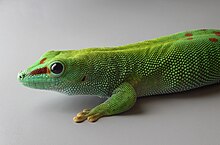Gekkonidae
The geconids (Gekkonidae) are a family of scaly sauropsids (reptiles), including small to medium-sized gecko species found in temperate and tropical climates of all the world.
The designation gecos comes from English gecko, which is a generalization of Gekko, the type genus of the family. Gekko in turn comes from a homophoneous Malay word, which is an onomatopoeia that reproduces the cry of an Indonesian species.
Features
Geckos have several peculiar features that clearly distinguish them from other lizards. They are unique for their vocalization, as they make screeching sounds in their interactions with other geckos. They are nocturnal in habit, with enormous eyes and endowed with lobed vertical pupils that allow an extraordinary range of variation in their opening. Many species have sticky pads on the soles of their feet that allow them to climb smooth vertical surfaces and even walk across roofs with ease. These abilities are well known among people living in temperate climates, where various species of gecko often move indoors. These species (for example the gecko) are part of the furniture and are rarely disturbed, since they feed on insects.
A lot of attention has been paid to gecko feet, as they stick to many types of surfaces without the need for liquids or surface tension. Recent studies of the setae (hairs) on the soles of gecko feet have shown that the attractive forces that keep the gecko attached to surfaces are Van der Waals forces.
The color of most geckos ranges from shades of brown to dark gray. Some species can change color to blend in with the environment or when stressed. However there are others that have bright colors.
Biology and ecology
Geconids are generally nocturnal and arboreal lizards. Like most lizards, they eat insects. Geckos are the only scaly geckos whose eggs have a hard shell. Some species are parthenogenetic, meaning that females can reproduce without mating with a male. This increases the gecko's ability to spread to new islands. Many geckos live in groups and use squeaks and chatter to communicate.
A notable case is that of the gecko Ptychozoon, which has skin membranes on its legs and on the sides of its body that act like parachutes to smooth its descents as it darts from tree to tree..
Many species of gecko are kept as pets.
Classification
The family contains about 1,500 species grouped into 58 genera:
- Afroedura Loveridge, 1944
- Afrogecko Bauer, Good & Branch, 1997
- Agamura Blanford, 1874
- Ailuronyx Fitzinger, 1843
- Alsophylax Fitzinger, 1843
- Altiphylax Yeriomtschenko " Shcherbak, 1984
- Blaesodactylus Boettger, 1893
- Bunopus Blanford, 1874
- Calodactylodes Strand, 1926
- Chondrodactylus Peters, 1870
- Christinus Wells & Wellington, 1984
- Cnemaspis Peters, 1869
- Crossobamon Boettger, 1888
- Cryptactites Bauer, Good & Branch, 1997
- Cyrtodactylus Gray, 1827
- Cyrtopodion Fitzinger, 1843
- Dixonius Bauer, Good & Branch, 1997
- Dravidogecko Smith, 1933
- Ebenavia Boettger, 1877
- Elasmodactylus Boulenger, 1895
- Geckolepis Grandidier, 1867
- Gehyra Gray, 1834
- Gekko Laurenti, 1768
- Goggia Bauer, Good & Branch, 1997
- Hemidactylus Gray, 1825
- Hemiphyllodactylus Bleeker, 1860
- Heteronotia Wermuth, 1965
- Homopholis Boulenger, 1885
- Kolekanos Heinicke, Daza, Greenbaum, Jackman & Bauer, 2014
- Lakigecko Torki, 2020
- Lepidodactylus Fitzinger, 1843
- Luperosaurus Gray, 1845
- Lygodactylus Gray, 1864
- Matoatoa Nussbaum, Raxworthy & Pronk, 1998
- Mediodactylus Szczerbak " Golubev, 1977
- Microgecko Nikolski, 1907
- Nactus Kluge, 1983
- Narudasia Methuen & Hewitt, 1914
- Pachydactylus Wiegmann, 1834
- Paragehyra Angel, 1929
- Paroedura Günther, 1879
- Parsigecko Safaei-Mahroo, Ghaffari, & Anderson, 2016
- Butchirus Boulenger, 1885
- Phelsuma Gray, 1825
- Pseudoceramodactylus Haas, 1957
- Pseudogekko Taylor, 1922
- Ptenopus Gray, 1866
- Ramigekko Heinicke, Daza, Greenbaum, Jackman & Bauer, 2014
- Rhinogekko De Witte 1973
- Rhoptropella Hewitt, 1937
- Rhoptropus Peters, 1869
- Stenodactylus Fitzinger, 1826
- Tenuidactylus Shcherbak & Golubev, 1984
- Trachydactylus Haas & Battersby, 1959
- Trigonodactylus Peters, 1880
- Tropiocolotes Peters, 1880
- Urocotyledon Kluge, 1983
- Uroplatus Dumeril, 1806
Contenido relacionado
Cyclocarya paliurus
Cneoraceae
Applied botany

